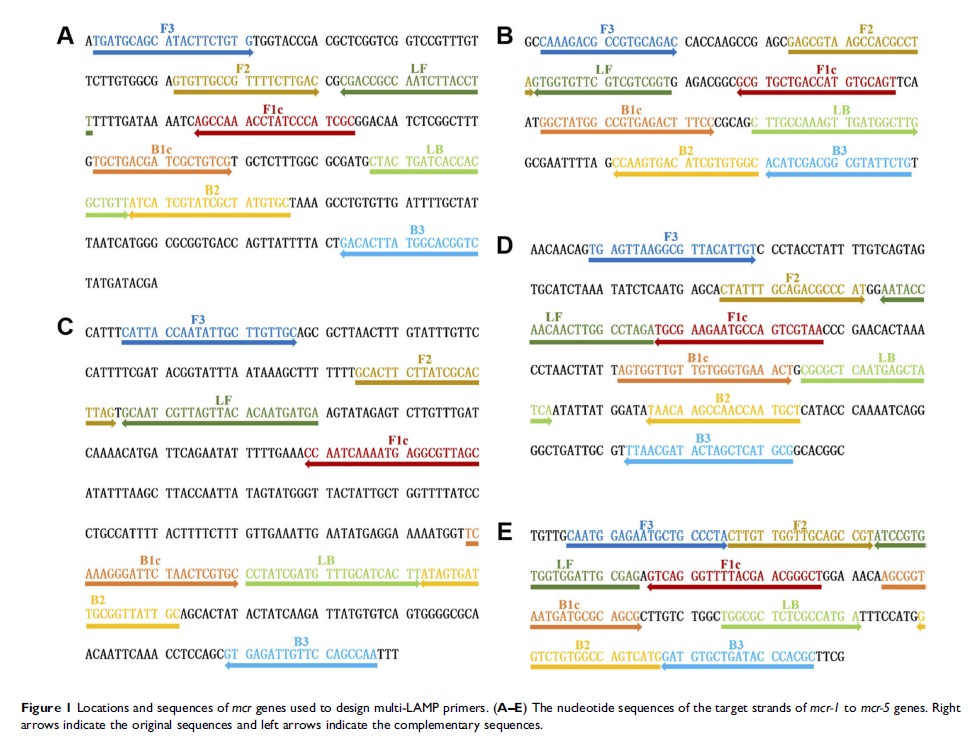9 0 8 1 0
论文已发表
注册即可获取德孚的最新动态
IF 收录期刊
- 2.6 Breast Cancer (Dove Med Press)
- 3.9 Clin Epidemiol
- 3.3 Cancer Manag Res
- 3.9 Infect Drug Resist
- 3.6 Clin Interv Aging
- 4.8 Drug Des Dev Ther
- 2.8 Int J Chronic Obstr
- 8.0 Int J Nanomed
- 2.3 Int J Women's Health
- 3.2 Neuropsych Dis Treat
- 4.0 OncoTargets Ther
- 2.2 Patient Prefer Adher
- 2.8 Ther Clin Risk Manag
- 2.7 J Pain Res
- 3.3 Diabet Metab Synd Ob
- 4.3 Psychol Res Behav Ma
- 3.4 Nat Sci Sleep
- 1.9 Pharmgenomics Pers Med
- 3.5 Risk Manag Healthc Policy
- 4.5 J Inflamm Res
- 2.3 Int J Gen Med
- 4.1 J Hepatocell Carcinoma
- 3.2 J Asthma Allergy
- 2.3 Clin Cosmet Investig Dermatol
- 3.3 J Multidiscip Healthc

多重循环介导的等温扩增(multi-LAMP)测定法,用于快速检测耐粘菌素细菌中的 mcr-1 至 mcr-5
Authors Zhong LL, Zhou Q, Tan CY, Roberts AP, El-Sayed Ahmed MAEG, Chen G, Dai M, Yang F, Xia Y, Liao K, Liang Y, Yang Y, Feng S, Zheng X, Tian GB
Received 27 March 2019
Accepted for publication 13 May 2019
Published 2 July 2019 Volume 2019:12 Pages 1877—1887
DOI https://doi.org/10.2147/IDR.S210226
Checked for plagiarism Yes
Review by Single-blind
Peer reviewers approved by Dr Melinda Thomas
Peer reviewer comments 2
Editor who approved publication: Professor Suresh Antony
Purpose: The discovery of the plasmid-mediated colistin resistance genes, mcr , revealed a mechanism of transmission of colistin resistance, which is a major, global public health concern especially among individuals infected with carbapenem-resistant Gram-negative bacteria. To monitor the spread and epidemiology of mcr genes, a convenient and reliable method to detect mcr genes in clinical isolates is needed, especially in the primary care institutions. This study aimed to establish a restriction endonuclease-based multiplex loop-mediated isothermal amplification (multi-LAMP) assay to detect mcr genes (mcr-1 to mcr-5 ) harbored by colistin-resistant bacteria.
Methods: A triple-LAMP assay for mcr-1 , mcr-3 , and mcr-4 and a double-LAMP assay for mcr-2 and mcr-5 were established. The sensitivity and specificity of the LAMP reactions were determined via electrophoresis and visual detection.
Results: The sensitivity of the LAMP assay was 10-fold greater than that of PCR, with high specificity among the screened primers. Specific mcr genes were distinguished in accordance with band numbers and the fragment length of the digested LAMP amplification products. Furthermore, the LAMP assay was confirmed as a rapid and reliable diagnostic technique upon application for clinical samples, and the results were consistent with those of conventional PCR assay.
Conclusion: The multi-LAMP assay is a potentially promising method to detect mcr genes and will, if implemented, help prevent infections by drug-resistant bacteria in primary-care hospitals due to rapid and reliable surveillance. To our knowledge, this is the first study to report the application of LAMP to detect mcr-2 to mcr-5 genes and the first time that multi-LAMP has been applied to detect mcr genes.
Keywords: mcr genes, colistin resistance, multi-LAMP, rapid detection, enzyme digestion
